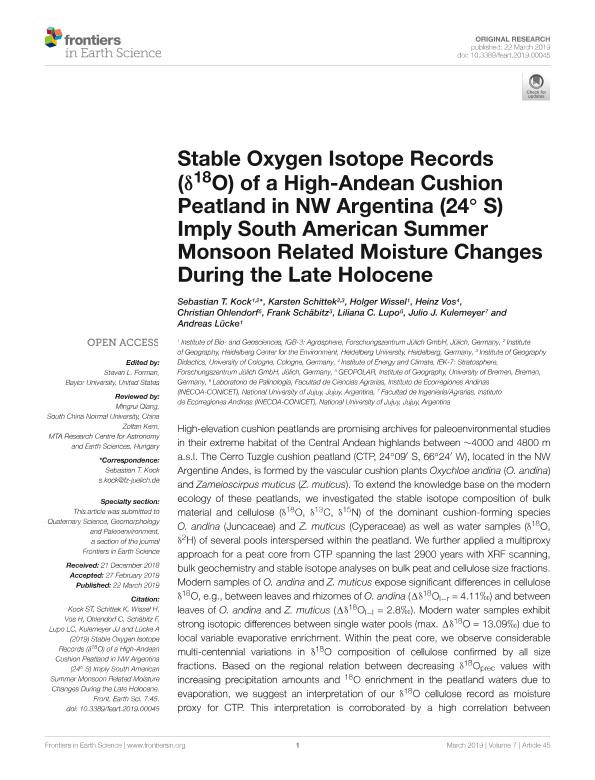Mostrar el registro sencillo del ítem
dc.contributor.author
Kock, Sebastian T.
dc.contributor.author
Schittek, Karsten

dc.contributor.author
Wissel, Holger
dc.contributor.author
Vos, Heinz
dc.contributor.author
Ohlendorf, Christian

dc.contributor.author
Schäbitz, Frank

dc.contributor.author
Lupo, Liliana Concepcion

dc.contributor.author
Kulemeyer, Julio José

dc.contributor.author
Lücke, Andreas

dc.date.available
2021-01-18T23:15:02Z
dc.date.issued
2019-02
dc.identifier.citation
Kock, Sebastian T.; Schittek, Karsten; Wissel, Holger; Vos, Heinz; Ohlendorf, Christian; et al.; Stable oxygen isotope records (δ 18 O) of a high-andean cushion peatland in nw Argentina (24° S) imply South American summer monsoon related moisture changes during the late holocene; Frontiers Media S.A.; Frontiers in Earth Science; 7; 45; 2-2019; 1-18
dc.identifier.issn
2296-6463
dc.identifier.uri
http://hdl.handle.net/11336/122957
dc.description.abstract
High-elevation cushion peatlands are promising archives for paleoenvironmental studies in their extreme habitat of the Central Andean highlands between ∼4000 and 4800 m a.s.l. The Cerro Tuzgle cushion peatland (CTP, 24°09′ S, 66°24′ W), located in the NW Argentine Andes, is formed by the vascular cushion plants Oxychloe andina (O. andina) and Zameioscirpus muticus (Z. muticus). To extend the knowledge base on the modern ecology of these peatlands, we investigated the stable isotope composition of bulk material and cellulose (δ 18 O, δ 13 C, δ 15 N) of the dominant cushion-forming species O. andina (Juncaceae) and Z. muticus (Cyperaceae) as well as water samples (δ 18 O, δ 2 H) of several pools interspersed within the peatland. We further applied a multiproxy approach for a peat core from CTP spanning the last 2900 years with XRF scanning, bulk geochemistry and stable isotope analyses on bulk peat and cellulose size fractions. Modern samples of O. andina and Z. muticus expose significant differences in cellulose δ 18 O, e.g., between leaves and rhizomes of O. andina (Δδ 18 O l-r = 4.11‰) and between leaves of O. andina and Z. muticus (Δδ 18 O l-l = 2.8‰). Modern water samples exhibit strong isotopic differences between single water pools (max. Δδ 18 O = 13.09‰) due to local variable evaporative enrichment. Within the peat core, we observe considerable multi-centennial variations in δ 18 O composition of cellulose confirmed by all size fractions. Based on the regional relation between decreasing δ 18 O prec values with increasing precipitation amounts and 18 O enrichment in the peatland waters due to evaporation, we suggest an interpretation of our δ 18 O cellulose record as moisture proxy for CTP. This interpretation is corroborated by a high correlation between oxygen isotopes, peat growth and geochemical data. Accordingly, CTP indicates dryer conditions between 2190 and 2120, 1750 and 1590, 1200 and 1080 and since 130 cal. yr BP, whereas periods with increased humidity prevailed from 2750 to 2250 and from 600 to 130 cal. yr BP. Temporal changes in the match to South American Summer Monsoon (SASM) reconstructions suggest impacts of other large-scale atmospheric variability modes or a different SASM expression at our southerly location.
dc.format
application/pdf
dc.language.iso
eng
dc.publisher
Frontiers Media S.A.

dc.rights
info:eu-repo/semantics/openAccess
dc.rights.uri
https://creativecommons.org/licenses/by-nc-sa/2.5/ar/
dc.subject
CELLULOSE
dc.subject
CENTRAL ANDES
dc.subject
CUSHION PEATLANDS
dc.subject
LATE HOLOCENE
dc.subject
PRECIPITATION
dc.subject
SASM
dc.subject
STABLE ISOTOPES
dc.subject.classification
Geociencias multidisciplinaria

dc.subject.classification
Ciencias de la Tierra y relacionadas con el Medio Ambiente

dc.subject.classification
CIENCIAS NATURALES Y EXACTAS

dc.title
Stable oxygen isotope records (δ 18 O) of a high-andean cushion peatland in nw Argentina (24° S) imply South American summer monsoon related moisture changes during the late holocene
dc.type
info:eu-repo/semantics/article
dc.type
info:ar-repo/semantics/artículo
dc.type
info:eu-repo/semantics/publishedVersion
dc.date.updated
2020-05-19T19:49:11Z
dc.journal.volume
7
dc.journal.number
45
dc.journal.pagination
1-18
dc.journal.pais
Estados Unidos

dc.description.fil
Fil: Kock, Sebastian T.. Helmholtz Gemeinschaft. Forschungszentrum Jülich; Alemania. Ruprecht Karls Universitat Heidelberg.; Alemania
dc.description.fil
Fil: Schittek, Karsten. Universitat zu Köln; Alemania. Ruprecht Karls Universitat Heidelberg.; Alemania
dc.description.fil
Fil: Wissel, Holger. Helmholtz Gemeinschaft. Forschungszentrum Jülich; Alemania. Ruprecht Karls Universitat Heidelberg.; Alemania
dc.description.fil
Fil: Vos, Heinz. Helmholtz Gemeinschaft. Forschungszentrum Jülich; Alemania. Ruprecht Karls Universitat Heidelberg.; Alemania
dc.description.fil
Fil: Ohlendorf, Christian. Universitat Bremen; Alemania
dc.description.fil
Fil: Schäbitz, Frank. Universitat zu Köln; Alemania
dc.description.fil
Fil: Lupo, Liliana Concepcion. Universidad Nacional de Jujuy. Instituto de Ecorregiones Andinas. Consejo Nacional de Investigaciones Científicas y Técnicas. Centro Científico Tecnológico Conicet - Salta. Instituto de Ecorregiones Andinas; Argentina
dc.description.fil
Fil: Kulemeyer, Julio José. Universidad Nacional de Jujuy. Instituto de Ecorregiones Andinas. Consejo Nacional de Investigaciones Científicas y Técnicas. Centro Científico Tecnológico Conicet - Salta. Instituto de Ecorregiones Andinas; Argentina
dc.description.fil
Fil: Lücke, Andreas. Helmholtz Gemeinschaft. Forschungszentrum Jülich; Alemania
dc.journal.title
Frontiers in Earth Science
dc.relation.alternativeid
info:eu-repo/semantics/altIdentifier/doi/http://dx.doi.org/10.3389/feart.2019.00045
dc.relation.alternativeid
info:eu-repo/semantics/altIdentifier/url/https://www.frontiersin.org/articles/10.3389/feart.2019.00045/full
Archivos asociados
